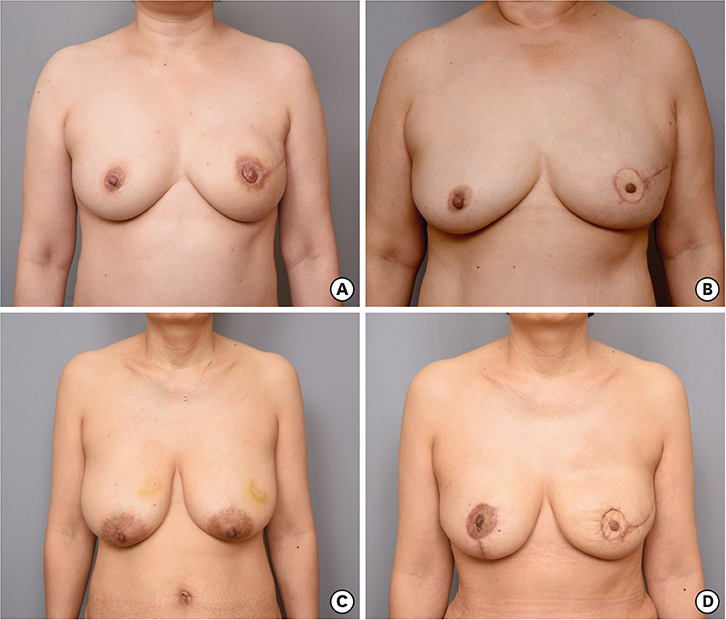J Breast Cancer.
2019 Dec;22(4):641-646. 10.4048/jbc.2019.22.e52.
Skin-sparing Mastectomy and Immediate Nipple Graft for Large, Ptotic Breast
- Affiliations
-
- 1Department of Plastic Surgery, Asan Medical Center, University of Ulsan College of Medicine, Seoul, Korea. nicekek@korea.com
- 2Department of Surgery, Asan Medical Center, University of Ulsan College of Medicine, Seoul, Korea.
- KMID: 2470900
- DOI: http://doi.org/10.4048/jbc.2019.22.e52
Abstract
- Nipple-areolar skin-sparing mastectomy followed by autologous reconstruction in patients with large, ptotic breasts often offers a limited field, resulting in strenuous traction. Skin-sparing mastectomy (SSM) with immediate nipple grafting from the specimen was attempted for such patients. Patients who underwent SSM with immediate autologous breast reconstruction and nipple grafting between September 2016 and February 2019 were evaluated, including 33 nipple grafts in 30 patients. The average weight of the mastectomy specimen was 552.5 g and the average operation time for unilateral mastectomy was 109 minutes. No complete nipple loss or major skin flap necrosis was reported. Adjuvant therapy started after an average of 24 days. SSM with immediate nipple grafting on the autologously reconstructed breast could be an alternative for large, ptotic breasts. It is also useful for patients requiring contralateral balancing procedures or those with bilateral breast cancer in which only one nipple can be spared oncologically.
MeSH Terms
Figure
Reference
-
1. Ito H, Ueno T, Suga H, Shiraishi T, Isaka H, Imi K, et al. Risk factors for skin flap necrosis in breast cancer patients treated with mastectomy followed by immediate breast reconstruction. World J Surg. 2019; 43:846–852.
Article2. Frey JD, Salibian AA, Karp NS, Choi M. The impact of mastectomy weight on reconstructive trends and outcomes in nipple-sparing mastectomy: progressively greater complications with larger breast size. Plast Reconstr Surg. 2018; 141:795e–804e.3. Endara M, Chen D, Verma K, Nahabedian MY, Spear SL. Breast reconstruction following nipple-sparing mastectomy: a systematic review of the literature with pooled analysis. Plast Reconstr Surg. 2013; 132:1043–1054.4. Carlson GW, Chu CK, Moyer HR, Duggal C, Losken A. Predictors of nipple ischemia after nipple sparing mastectomy. Breast J. 2014; 20:69–73.
Article5. Yang SJ, Eom JS, Lee TJ, Ahn SH, Son BH. Recipient vessel selection in immediate breast reconstruction with free abdominal tissue transfer after nipple-sparing mastectomy. Arch Plast Surg. 2012; 39:216–221.
Article6. Frey JD, Choi M, Salibian AA, Karp NS. Comparison of outcomes with tissue expander, immediate implant, and autologous breast reconstruction in greater than 1000 nipple-sparing mastectomies. Plast Reconstr Surg. 2017; 139:1300–1310.
Article7. Mastroianni M, Lin AM, Smith BL, Austen WG Jr, Colwell AS. Nipple loss following nipple-sparing mastectomy. Plast Reconstr Surg. 2016; 138:24e–30e.
Article8. Dent BL, Chao JW, Eden DJ, Stone BV, Swistel A, Talmor M. Nipple resection and reconstruction after attempted nipple-sparing mastectomy. Ann Plast Surg. 2017; 78:28–34.
Article9. van Verschuer VM, Mureau MA, Gopie JP, Vos EL, Verhoef C, Menke-Pluijmers MB, et al. Patient satisfaction and nipple-areola sensitivity after bilateral prophylactic mastectomy and immediate implant breast reconstruction in a high breast cancer risk population: nipple-sparing mastectomy versus skin-sparing mastectomy. Ann Plast Surg. 2016; 77:145–152.
Article
- Full Text Links
- Actions
-
Cited
- CITED
-
- Close
- Share
- Similar articles
-
- Immediate Reconstruction of Large Ptotic Breasts following Vertical Reduction Pattern Nipple-Sparing Mastectomy
- Batwing-shaped de-epithelialization technique: a case report
- Immediate Breast Reconstruction with TRAM Flap after Nipple-Areolar Sparing Mastectomy
- Skin - sparing Mastectomy with Circumareolar Incision and Immediate TRAM & One - stage Star Flap Nipple - areolar Complex Reconstruction
- One-stage nipple and breast reconstruction using a deep inferior epigastric perforator flap after a skin-sparing mastectomy



